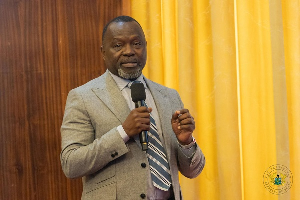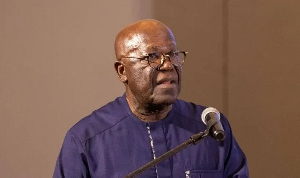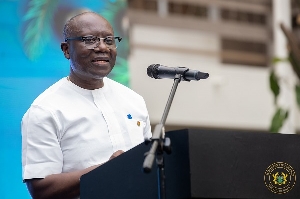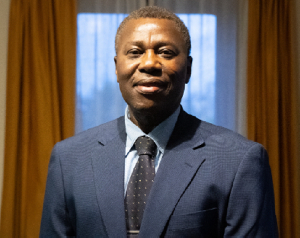By Kwame Okoampa-Ahoofe, Jr., Ph.D.
Not very long ago, a colleague with whom I am no longer on speaking terms – he, it was, who took the initiative, and has even since dastardly resorted to leaving verbally pornographic messages on my official voice-mail system nearly every other week, for some two years now – wore one of those faux-propaganda cotton-prints to campus. His fady-looking raw-cotton fabric was emblazoned with the following legend: “Fifty Years of Brong-Ahafo.” I suppose the fella expected me to readily surmise what the legend spanning his rather broad chest alluded to; and when I did not seem to do so, he visibly appeared crestfallen and utterly disappointed.
Of course, I was vividly aware of what Tawia Adamafio’s “Osagyefo” had attempted to do with Ghana’s internal geopolitical boundaries, ironically, at the same time that he loudly and rhapsodically gushed to the rest of his fellow premiers about the imperative need not to further “Balkanize” the African continent. And for those of our readers who may not know this, it was President Nkrumah, in a grossly ill-advised effort to breaking the spine of the Great Asante Federation, who carved out what had hitherto been known as Western Asante, in the British colonial era, into present-day Brong-Ahafo Region.
Like ex-President Jeremiah John Rawlings, vis-à-vis the Volta regional electorate, Mr. Kwame Nkrumah had, somehow, managed to convince some Western-Asante leaders that he, the great beacon of Nzemaland, was keenly about the sacred business of “liberating” the Brong (Bono) and Ahafo people from the crushing yoke of Asante imperialism. We intend to take up the latter issue in a future article. At any rate, my colleague went on to fatuously gush about how “The Osagyefo” had liberated the “Bono” from “Asante tyranny.” I riposted by reminding him that only a clinical cretin would presume Nkrumah to have also liberated the “Ahafo” from Great Asante. The fella seemed even more bewildered, as I hurriedly departed the scene, with him apparently rooted to the spot.
The preceding, of course, brings me to the recent announcement by Vice-President John Dramani Mahama to the Gonja Traditional Council (GTC) and delegates to the 33rd Annual Congress of the Gonjaland Youth Association (GYA), that the government of the National Democratic Congress (NDC) was fervidly engaged in the ungodly process of carving the Northern Region into two separate provincial administrative spheres, namely, North-East and North-West regions. Actually, the Vice-President had made absolutely no mention of the new names to be given these two northern enclaves. Following his argument closely, however, one gets the plausible hunch that, more likely, an evenly divided Northern Region would be named Dagombaland and Gonjaland. One also has the quite plausible feeling that the Gonja people, from whom Mr. Mahama hails, having also represented them in the Ghanaian parliament, have been motivated to seek their own separate region in no small part because of the raging and seemingly interminable Dagbon chieftaincy crisis. The latter state of affairs, needless to say, has tended to almost completely overshadow all other activities in the region, particularly issues of local and regional development. Thus, in a real sense, what Vice-President Mahama and the Gonja people appear to be saying is simply that it is high time the Dagbon people localized their seemingly intractable and bloody chieftaincy disputes and stop pretending as if everybody was keenly interested in their familial affairs, merely because they happen to share the same region or administrative apparatus.
What is interesting here, though, is that since 1982, all the creations of new regions, including the official promulgation of Greater-Accra as a regional metropolis, have been undertaken by the so-called Provisional National Democratic Congress (P/NDC), most notably Monsieur Jeremiah John Rawlings; and there is no reason not to believe that the devil, as it were, is also in the details of this Gonja clamor for a separate regional administrative machinery.
The logic behind Vice-President Mahama’s call for the carving up of the Northern Region into two discrete entities, largely on grounds of sheer land size, is rather lame, especially since the ultimate rationale has clearly been given as one of human and economic development. Perhaps somebody ought to enlighten Mr. Mahama about the practical and commonsensical concept of Economies of Scale, an ideology which pretty much informs the existence of the Economic Community of West African States (ECOWAS). We must also highlight, for the benefit of the major players involved, that the P/NDC’s “tactical” balkanization of the country from seven (7) into ten (10) regions has not served any appreciable or economically meaningful purpose, which explains why the Upper-East and Upper-West regions continue to seriously lag behind the rest of their southern counterparts, including, of course, the Northern Region itself! On the other hand, we must also significantly observe the fact that the tactical balkanization of Ghana by the P/NDC has enabled the latter to gain a groundswell of following by this very fact, as the tactically balkanized have, curiously, come to assume a false sense of improved political status. What needs to be seriously taken into account is that the logic of population density and pressure dictates that should the Gonja people succeed in getting the Northern Region (Estimated Population as of the 2000 Census: 1.8 million) carved into at least two ministerial spheres – some are actually agitating for more – then it equally stands to reason for the Asante Region (Population: 3.2 million) to be divided into at least three ministerial spheres of influence, with Greater-Accra (Population: 3 million), Eastern (Population: 2.2 million), Western (Population: 2 million) and Brong-Ahafo (Population: 2 million) regions in close contention. Our good guess here, however, is that, other than the Northern Region, none of the preceding regions are likely to crave “tactical balkanization” anytime soon.
It is also quite amusing for some promoters of a balkanized Northern Region to be advancing their thesis on grounds of ethnic diversity ( See “Move to Split Northern Region Inspirational” Ghanaweb.com 4/18/09), almost as if the Eastern Region, for example, could not lay forth a far better claim to ethnic diversity than the Northern Region.
Needless to say, the real implications of creating more regions lie in increased bureaucracy, huge public expenditure and compound corruption. And it is in the foregoing areas that such regional balkanization process ought to be envisaged, particularly in terms of the likely marked drain on our national economy. For the creation of additional regions also implies the consonant establishment of a capital-intensive bureaucratic apparatus, including, of course, the massive construction of administrative and residential complexes, as well as humongous payrolls, all of which may aptly be envisaged to run contrary to President Atta-Mills’ much-touted agenda of maintaining a lean and cost-effective bureaucratic culture. Perhaps those agitating for the creation of two Northern Regions ought to ask our oil-rich Nigerian neighbors what palpably significant economic gains redounded to the benefit of their decision to expanding their regional administrative apparatus from twenty-one (21) to thirty-six (36) some two decades ago. Indeed, in 1990-91, this writer, then a columnist for a weekly newspaper called Nigerian News Digest, later renamed African News Weekly, vigorously questioned the viability of the creation of such cancerous-multiplicity of states, amidst a torrent of insolent and vitriolic rejoinders. The good news, at least on the part of this author, is that twenty years later, Nigeria’s per capita income is still significantly lower than that of Ghana. But what amused me then, as I vividly recall, was the fact that many of the best Nigerian secondary schools had to be unwisely shuttered and converted into regional administrative offices and residential quarters. Believe me, dear reader, the rules of commonsensical pragmatism, twenty years later, is no different for Ghanaians! In other words, our unflappable conviction here is that what our entire country needs, not just the Gonja people or the Northern Region, is a responsible and religiously accountable leadership, not convenient, tactical and self-serving balkanization of the land.
*Kwame Okoampa-Ahoofe, Jr., Ph.D., is Associate Professor of English, Journalism and Creative Writing at Nassau Community College of the State University of New York, Garden City. He is the author of 20 books, including “Dr. J. B. Danquah: Architect of Modern Ghana” (iUniverse.com, 2005). E-mail: okoampaahoofe@aol.com. ###
Opinions of Wednesday, 22 April 2009
Columnist: Okoampa-Ahoofe, Kwame














